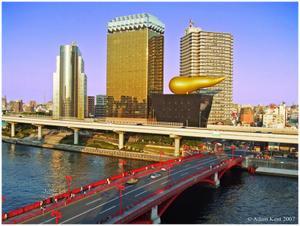Advertisement

 "Golden Flame"
"Golden Flame"
The 'Asahi Breweries' buildingAn absolutely sweltering day today, decided to wander up the road to Asakusa again to have a proper look, and find out about Senso-ji Temple, Tokyo's oldest established temple.
The origins of Asakusa Kannon and Senso-ji Temple... According to the legend about the origin of Senso-ji Temple, two fishermen, Hinokuma Hamanari and his brother Takenari, discovered an image of Kannon (the Buddhist goddess of mercy) in the Sumida River in 628, and together with the headman of their village Haji-no-Nakatomo, built a hall to worship the image. Twenty years later, the Buddhist priest Shokai erected a Kannon temple at this spot. In March 1945, during World War II, the temple was burned down in an air raid and then reconstructed in 1958. Formally named Kinryuzan Senso-ji, but better known as Asakusa Kannon, it is the oldest established temple in the Tokyo area.
The Asakusa district has flourished, with the temple as its focal point, since the Edo period. The town is still visited by crowds of worshippers 365 days a year, who come to pay their respects at the popular Asakusa Kannon.
The Komagata-do Hall marks the exact spot where the Kannon image was discovered, according to

 Kaminarimon Gate
Kaminarimon Gate
The main gate of Senso-ji Temple. The deity on the right is Fujin, the god of wind, and the one on the left is Raijin, the god of thunder. It is formally called the Furaijinnmon. The year in which it was built is unknown.the temple's legend. Beside the hall is the Asakusa Kannon Kaisatsu Monument, with an engraved message asking people to refrain from killing animals or fishing in the vicinity to honour the appearance of Kannon.
Advertisement
Tot: 0.135s; Tpl: 0.012s; cc: 18; qc: 69; dbt: 0.0683s; 1; m:domysql w:travelblog (10.17.0.13); sld: 1;
; mem: 1.2mb

 "Golden Flame"
"Golden Flame"
 Kaminarimon Gate
Kaminarimon Gate





































ian
non-member comment
t-shirt
If you get down to kamakura pick up a t-shirt for me - mine got worn out and I don't think I'll get back again in the near future - it's a long way from Pill